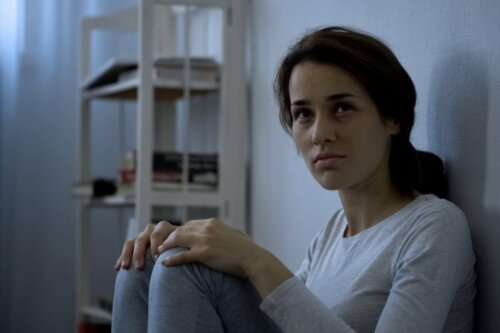Origin of the Crow Types of Schizophrenia

Schizophrenia is a psychotic spectrum disorder characterized by positive symptoms such as hallucinations, delusions, and disorganized thinking. The negative symptoms could be apathy and anhedonia, and the cognitive symptoms usually present themselves in the form of attentional disturbances. This is a chronic and disabling disorder and the object of much interest in experts from various disciplines. Today’s article will discuss the Crow types of schizophrenia. They’re named after Timothy Crow, an English psychiatrist born in 1938 who distinguished two variants of this disorder during his research in 1980.
Timothy Crow’s classification is important because it relates to the different factors of the medical model such as syndrome, course, etiology, treatment, and prognosis, among others. The author initially distinguished type I schizophrenia (positive) and type II schizophrenia (negative).
However, he reformulated his classification seven years later, in 1987. This is because he considered that not all cases fit his dichotomous classification. Thus, he also included mixed types of schizophrenia.
The categorical model of T. Crow is currently in disuse, although his proposal was rather interesting. To this day, some professionals still find it useful (on a practical and academic level). In addition, the classification allows doctors to know more about the reality of this disorder. Ok, but what are the two Crow types of schizophrenia? What’s the difference between them? Continue reading to find out.
“Oh, and I certainly don’t suffer from schizophrenia. I quite enjoy it. And so do I.”
-Emilie Autumn-

Crow types of schizophrenia
As we mentioned above, there are two types of Crow’s schizophrenia:
- Type I (positive).
- Type II (negative).
This classification is no longer followed to diagnose nor reflected in the reference for mental health manuals (DSM-5 and ICD-10). However, it was the main reference at the time. Without further ado, let’s delve into the types of schizophrenia this psychiatrist proposed and see how they differ:
Type I schizophrenia (positive)
It has this name because positive symptoms such as hallucinations, delusions, positive thought disturbances (for example, disorganization), and disorganized behavior predominate.
The author likens this type of schizophrenia to the paranoid subtype, found in the DSM-IV-TR (although no longer in the DSM-5).
- Premorbid fit. This is positive. In other words, the patient was more or less adapted before the appearance of the first symptoms of the disorder.
- Start, course, and forecast. Here, the onset of type I schizophrenia is acute (vs. the onset of type II schizophrenia, which is insidious). What this means is that the symptoms appear abruptly. Also, its course is sharp, with sprouts and remissions. In schizophrenia II, on the other hand, the course is chronic and defective. Type I schizophrenia is reversible but type II is irreversible. This is mostly due to the good response to neuroleptics of schizophrenia I patients and the poor response of type II patients.
- Neuropsychological impairment in this type of schizophrenia is absent and about possible deficits or alterations in cognitive processes. Let’s say that cognitive symptoms (cognitive disorders) appear in certain people with a diagnosis of schizophrenia, as suggested by a study by Barrera et al. (2006). According to it, some of the most affected aspects are declarative memory, executive functions, and sustained attention.
- At the pathological process level, type I schizophrenia produces a series of neurochemical alterations. Specifically, according to Crow, there’s an increase in dopamine D2 receptors. Keep in mind that the neurotransmitter dopamine is strongly implicated in schizophrenia here (specifically, an excess of dopamine). In the case of type II schizophrenia, the alterations are structural, as you’re about to see.
Type II schizophrenia (negative)
The second of Crow types of schizophrenia, type II, or negative, resembles the disorganized subtype of schizophrenia (DSM-IV-TR). This is due to the symptoms and characteristics of this subtype. Thus, the symptoms of this type of schizophrenia are negative and include affective flattening, poor language, and loss of impulse.
- Premorbid fit. Unlike what happened in the previous type, the premorbid adjustment in type II schizophrenia is bad. In other words, the patient’s functioning was already altered before the symptoms of the disorder even manifested.
- Start, course, and forecast. The onset of type II schizophrenia is insidious, meaning that the symptoms appear progressively. The course is chronic and defective, and the prognosis is irreversible. As you saw above, these patients respond poorly to neuroleptics.
- Neuropsychological impairment. The neuropsychological deterioration is present here and the affected individual may present deficits or alterations in the cognitive area. This includes memory, attention, executive functions, etc.
- Pathological process. A structural alteration occurs at the brain level and results in a cellular loss in the structures of the temporal lobe and the parahippocampal gyrus.

Crow types of schizophrenia
As you can see, type I schizophrenia has the best prognosis because it’s reversible, and the response to neuroleptics is adequate. Regarding the symptoms, those of type I are positive, while those of type II are negative.
The presentation of type I is evident and its course is acute, unlike type II, where the appearance of symptoms is more subtle and its course is chronic.
To this day, it’s true that the individual presentation of the disorder may be more similar to one or another type of those proposed by Crow, although no one’s technically diagnosed with the label of type I or II schizophrenia. However, it still seems risky to try to “fit” patients into a specific group. In other words, it’s clear that every person has their own idiosyncrasies (and more so in mental health).
Other classifications
Timothy Crow wasn’t the only author who researched to classify and group the different types of schizophrenia. German psychiatrist Emil Kraepelin (1856-1926) and Swiss psychiatrist Eugen Bleuler (1857-1939) did so before him.
Kraepelin distinguished the following types of schizophrenia: paranoid, catatonic, and hebephrenic (disorganized). Bleuler made the same classification as his colleague, but also added a new subtype: simple schizophrenia.
All cited sources were thoroughly reviewed by our team to ensure their quality, reliability, currency, and validity. The bibliography of this article was considered reliable and of academic or scientific accuracy.
- American Psychiatric Association (2000). DSM-IV-TR. Diagnostic and statistical manual of mental disorders (4thEdition Reviewed). Washington, DC: Author.
- Belloch, A., Sandín, B. y Ramos, F. (2010). Manual de Psicopatología. Volumen II. Madrid: McGraw-Hill.
- Cooke, A. (2015). Comprender la psicosis y la esquizofrenia. Londres: British Society Division of Clinical Psychology.
This text is provided for informational purposes only and does not replace consultation with a professional. If in doubt, consult your specialist.








